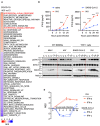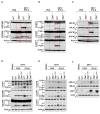ZBP1-dependent inflammatory cell death, PANoptosis, and cytokine storm disrupt IFN therapeutic efficacy during coronavirus infection
- PMID: 35587515
- PMCID: PMC9161373
- DOI: 10.1126/sciimmunol.abo6294
ZBP1-dependent inflammatory cell death, PANoptosis, and cytokine storm disrupt IFN therapeutic efficacy during coronavirus infection
Abstract
Severe acute respiratory syndrome coronavirus 2 (SARS-CoV-2), the virus responsible for coronavirus disease 2019 (COVID-19), continues to cause substantial morbidity and mortality in the ongoing global pandemic. Understanding the fundamental mechanisms that govern innate immune and inflammatory responses during SARS-CoV-2 infection is critical for developing effective therapeutic strategies. Whereas interferon (IFN)-based therapies are generally expected to be beneficial during viral infection, clinical trials in COVID-19 have shown limited efficacy and potential detrimental effects of IFN treatment during SARS-CoV-2 infection. However, the underlying mechanisms responsible for this failure remain unknown. In this study, we found that IFN induced Z-DNA-binding protein 1 (ZBP1)-mediated inflammatory cell death, PANoptosis, in human and murine macrophages and in the lungs of mice infected with β-coronaviruses, including SARS-CoV-2 and mouse hepatitis virus (MHV). In patients with COVID-19, expression of the innate immune sensor ZBP1 was increased in immune cells from those who succumbed to the disease compared with those who recovered, further suggesting a link between ZBP1 and pathology. In mice, IFN-β treatment after β-coronavirus infection increased lethality, and genetic deletion of Zbp1 or its Zα domain suppressed cell death and protected the mice from IFN-mediated lethality during β-coronavirus infection. Overall, our results identify that ZBP1 induced during coronavirus infection limits the efficacy of IFN therapy by driving inflammatory cell death and lethality. Therefore, inhibiting ZBP1 activity may improve the efficacy of IFN therapy, paving the way for the development of new and critically needed therapeutics for COVID-19 as well as other infections and inflammatory conditions where IFN-mediated cell death and pathology occur.
Figures





References
-
- Bavel J. J. V., Baicker K., Boggio P. S., Capraro V., Cichocka A., Cikara M., Crockett M. J., Crum A. J., Douglas K. M., Druckman J. N., Drury J., Dube O., Ellemers N., Finkel E. J., Fowler J. H., Gelfand M., Han S., Haslam S. A., Jetten J., Kitayama S., Mobbs D., Napper L. E., Packer D. J., Pennycook G., Peters E., Petty R. E., Rand D. G., Reicher S. D., Schnall S., Shariff A., Skitka L. J., Smith S. S., Sunstein C. R., Tabri N., Tucker J. A., Linden S. V., Lange P. V., Weeden K. A., Wohl M. J. A., Zaki J., Zion S. R., Willer R., Using social and behavioural science to support COVID-19 pandemic response. Nat. Hum. Behav. 4, 460–471 (2020). 10.1038/s41562-020-0884-z - DOI - PubMed
-
- Huang C., Wang Y., Li X., Ren L., Zhao J., Hu Y., Zhang L., Fan G., Xu J., Gu X., Cheng Z., Yu T., Xia J., Wei Y., Wu W., Xie X., Yin W., Li H., Liu M., Xiao Y., Gao H., Guo L., Xie J., Wang G., Jiang R., Gao Z., Jin Q., Wang J., Cao B., Clinical features of patients infected with 2019 novel coronavirus in Wuhan, China. Lancet 395, 497–506 (2020). 10.1016/S0140-6736(20)30183-5 - DOI - PMC - PubMed
Publication types
MeSH terms
Substances
Associated data
Grants and funding
LinkOut - more resources
Full Text Sources
Research Materials
Miscellaneous

